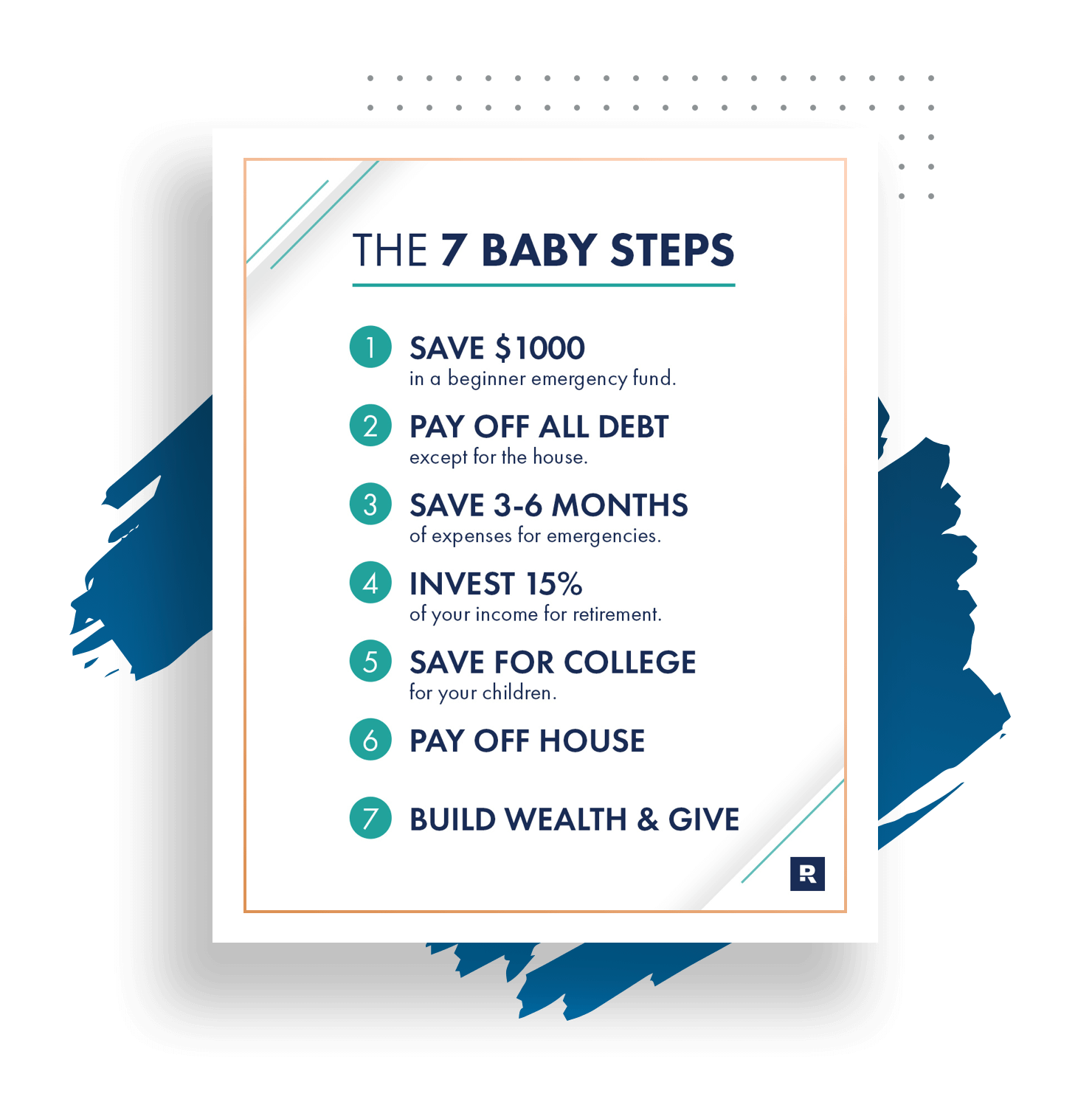How to Stay Motivated Through Baby Step 2
9 Min Read | May 24, 2023

The average student graduates from college with over $35,000 in student loan debt.1
Many students don’t have savings, so they use credit cards to pay for things they need after graduation, like the deposit on a new apartment—and the furniture and appliances for that new apartment.
A few months later, they get a new car to go with their new life. But when the bills start rolling in and the grace period on the student loans is over, those same students get the kind of check you can’t cash: a reality check.
You guys, this is the reality for so many young people in America. This is how people in their 20s rack up debt that feels like it’ll take the rest of their lives to pay off. And after years of drowning in that debt and interest—oh, the interest—they want something to change. They need something to change.
This is when people are ready to start Ramsey’s proven plan for becoming debt-free and building wealth: the 7 Baby Steps.
Using the 7 Baby Steps
Maybe you’re a recent college graduate, a single parent or someone who’s quickly approaching retirement. No matter your life stage, paying off your consumer debt puts you knee-deep in the hardest of the Baby Steps—Baby Step 2—where you pay off your debt using the debt snowball method.
 Why Baby Step 2 Is the Hardest Baby Step
Why Baby Step 2 Is the Hardest Baby Step
Baby Step 2 can often feel like climbing a mountain . . . in 100-degree heat . . . with a backpack full of bowling balls.
But going through this step will teach you so much about yourself. You’ll become more disciplined and patient than you ever imagined. You’ll learn you’re actually capable of saying no if it means sticking to your goals. And most of all, you’ll realize you’re resilient.
Yes, Baby Step 2 requires some sacrifices—especially if you’re not used to turning down vacations and bougie dinners. In Baby Step 2, you’re working more hours than you ever thought you could handle. You’re eating rice and beans. You haven’t gone to the movies or stepped foot in a restaurant in months.
But you’re gazelle intense, so it’s easy at first. In fact, one of the great things about the debt snowball is that you see progress from the beginning. You’re paying off the smallest bills and winning left and right. You’re motivated! You’re on fire! (Cue Alicia Keys.)
But what happens when the snowball starts to slow down—and your motivation pauses with it? This is when Baby Step 2 becomes harder than all the sacrifices and extra hours worked.
This is the point when you have to dig your heels in and say, “I’m in it for the long haul.”
7 Ways to Stay Motivated When You’re Getting Out of Debt
Getting out of debt won’t be easy, but it doesn’t have to be miserable. Here are seven ways to stay motivated through Baby Step 2.
1. You need an “I’ve had it” moment!
Does debt make you mad? It should!
Think about what debt is keeping you from doing and how those monthly payments make you feel. If you’re going to fully commit to Baby Step 2, you’ve got to see debt for what it is—the enemy. You need to say, “I’ve had it!”
When you’re down to your last few debts, the big ones—or even the final one—and you aren’t seeing those small wins anymore, it’s easy to feel like you’re running on fumes and getting no traction.
Pay off debt fast and save more money with Financial Peace University.
But you guys, this your defining moment. Quitting is normal, and so is debt—but if you’re following the Ramsey Baby Steps, you’re done with normal. Your money mindset is laser-focused. How badly do you want to be debt-free?
2. Remember your why.
Before you got here, you probably had a really good reason to start the Baby Steps. You might not even be aware of what it was other than needing to make a change with your money.
But let’s dig deeper. What’s your why? What are the reasons you want to kick debt to the curb for good?
Maybe your dream is to build a legacy—to create a home where your children will never watch their parents stress out about paying for groceries or the minimum payment on their credit card bill. Maybe you want to pursue a passion or start a business. Or maybe you want to build wealth, live and give like no one else . . . but you have to get out of debt first.
Get specific with whatever your why is and keep it at the forefront of your mind by creating a vision board on paper or on Pinterest. When you’re feeling discouraged, those images will remind you of how you’re going to feel once you’re debt-free. Every sacrifice you make today gets you closer to the kind of future you want to live.
To learn more about how to stay connected to your why, check out my new book: Know Yourself, Know Your Money.
3. Break down your goals.
Instead of looking at $50,000 of debt and screaming like Kevin McCallister in Home Alone (you know the face), break that amount up into smaller chunks. Whether it’s increments of $5,000 or $500, set little goals that feel easier to knock out.
The momentum created by achieving small goals is the reason the debt snowball works so well. Scratching another credit card off the list or kicking a car loan to the curb is a lot like tossing bowling balls out of your backpack—you suddenly feel a lot lighter, and the climb doesn’t seem as impossible as it did before. We need those small wins to energize us and remind us that our goals are totally doable.
4. Create a visual to track your progress.
Because so many of us are visual learners, it can help to actually see your progress toward your money goals.
You can place a sticky note on your bathroom mirror to remind yourself how much debt you have left. Maybe you want to draw a piggy bank on poster board and color it in as you pay off your debts. Having visual reminders will keep your goal on your mind and help you reach it faster.
5. Set small rewards along the way.
We know you love rice and beans seven days a week, but it’s okay to give yourself small rewards to stay motivated until the last debt is paid in full. You could treat yourself to something as small as a latte from your favorite coffee shop, or maybe snag some shoes that are on sale.
Better yet, add those rewards to your visual tracker to have something to look forward to when you reach a goal! You choose your rewards—just make sure they aren’t so extravagant that they slow down your progress.
Ron B. in our Facebook community has a great system in place to reward himself with little treats any time he hits a milestone: “Pay off a tire account? Budget a dinner out next month. Pay off a credit card? Budget a day out of the house and have some fun or add $25 to each other’s pocket money for the month. You’ve got to have things like that or you’ll resent the journey.”
6. Quit the comparisons.
Comparisons doesn’t just steal your joy—it steals your paycheck too. It’s great to get inspired by other people’s stories, but don’t compare your story to theirs. Everyone is on a different journey.
If you’re a one-income family of four making $45,000 a year, your progress is probably going to look a little different than a DINK (dual income, no kids) couple pulling in $120,000 a year. Or let’s say you have $3,000 in credit card debt and that’s it. You’re going to plow through your debt snowball pretty fast compared to someone who’s working to pay off $90,000 of debt. And that’s all okay!
We’re all climbing that mountain, but it’s definitely not a race. When we start comparing ourselves to other people, we’re playing a game we’ll never win.
7. Find your cheerleaders.
If you’re on Baby Step 2, you’re not alone. Reaching your goals is much easier when you have people walking alongside you. Everyone needs a cheerleader!
In fact, that’s one of the reasons why I created The Rachel Cruze Show. I wholeheartedly believe that money should be fun and simple—not stressful. So, I want to walk with you through Baby Step 2 and beyond! If podcasts are more your thing, you can listen and get your daily pep talk while doing the dishes or driving to work.
And be sure to check out my official Facebook Community for accountability and support from others who are on the same journey as you.
Of course, one of the best ways to stay motivated and keep your gazelle intensity is to take Financial Peace University. This nine-lesson course teaches you the step-by-step plan for paying off debt fast so you can start saving more money for the future.
Have you already been through Financial Peace University? Being a coordinator is a great way to stay motivated and accountable while also encouraging others.
Your Sacrifices Matter Most in Baby Step 2
When it gets hard, remember this: What you’re doing in Baby Step 2 matters. The decisions you’re making today are changing the landscape of your future. You’re rewriting your future—and the future of your children, and their children too. You’re transforming your family tree. You’re paving the way to leave a legacy.
Making sacrifices to get out of debt is weird, but don’t settle for normal. Look at what’s at stake if you quit. Don’t give up now—you’ve got this!


